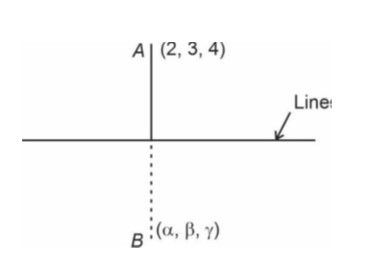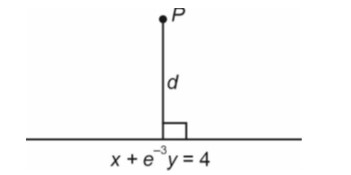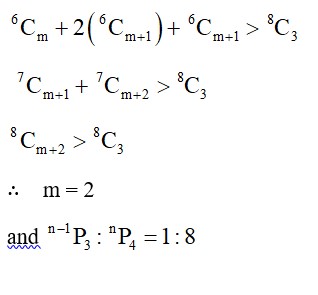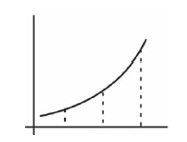Maths
Get insights from 6.5k questions on Maths, answered by students, alumni, and experts. You may also ask and answer any question you like about Maths
Follow Ask QuestionQuestions
Discussions
Active Users
Followers
New answer posted
a month agoContributor-Level 10

Slope of axis =
⇒ 2y – 6 = x – 2
⇒ 2y – x – 4 = 0
2x + y – 6 = 0
4x + 2y – 12 = 0
α + 1.6 = 4 ⇒ α = 2.4
β + 2.8 = 6 ⇒ β = 3.2
Ellipse passes through (2.4, 3.2)
⇒
Also
New answer posted
a month agoContributor-Level 10

Take
x = 2λ + 1, y = 3λ + 2, z = 4λ + 3
= (α − 2)
Now,
(α − 2) ⋅ 2 + (β − 3) ⋅3 + (γ − 4) ⋅ 4 = 0
2α − 4 + 3β − 9 + 4γ −16 = 0
⇒ 2α + 3β + 4γ = 29
New answer posted
a month agoContributor-Level 10
(3x2 − 3)
= ⋅ 3(x −1)(x +1)
For x ∈ (−∞, −1], f '(x) ≥ 0
∴ f(x) is increasing function
∴ a = e–∞ = 0 = f (−∞)
b = e−1+3+1 = e3 = f (−1)
∴ P(4, e3 + 2)

New answer posted
a month agoContributor-Level 10
(y – 2) = m (x – 8)
⇒ x-intercept
⇒
⇒ y-intercept
⇒ (–8m + 2)
⇒ OA + OB =
->
->
->
->Minimum = 18
New answer posted
a month agoContributor-Level 10
Take esinx = t (t > 0)
⇒
⇒
->t2 – 2t – 2 = 0
->t2 – 2t + 1 = 3
⇒ (t −1)2 = 3
⇒ t = 1 ±
⇒ t = 1 ± 1.73
⇒ t = 2.73 or –0.73 (rejected as t > 0)
⇒ esin x = 2.73
->loge esin x = loge 2.73
⇒ sin x = loge 2.73 > 1
So no solution.
New answer posted
a month agoContributor-Level 10
z1 + z2 = 5
⇒ 20 + 15i = 125 – 15z1z2
⇒ 3z1z2 = 25 – 4 – 3i
3z1z2 = 21– 3i
z1⋅z2 = 7 – i
(z1 + z2)2 = 25
= 11 + 2i
= 121 − 4 + 44i
⇒
⇒ = 117 + 44i − 2(49 −1−14i )
= 21 + 72i
⇒
New answer posted
a month agoNew answer posted
a month agoContributor-Level 10
Let
Given .(1)
∴ x1 + z1 = 2 … (2)
x2 + z2 = 0 … (3)
x3 + z3 = 0 … (4)
Given
⇒ – x1 + z1 = −4 … (5)
–x2 + z2 = 0 … (6)
–x3 + z3 = 4
Taking an Exam? Selecting a College?
Get authentic answers from experts, students and alumni that you won't find anywhere else
Sign Up on ShikshaOn Shiksha, get access to
- 65k Colleges
- 1.2k Exams
- 679k Reviews
- 1800k Answers






